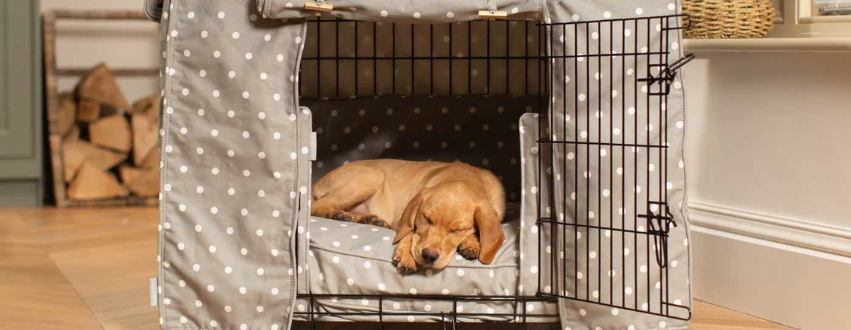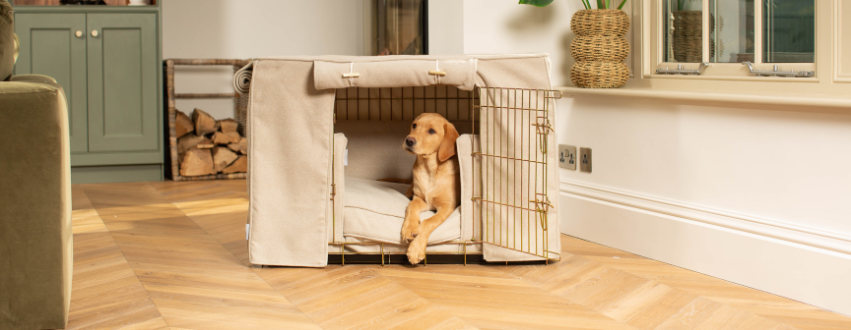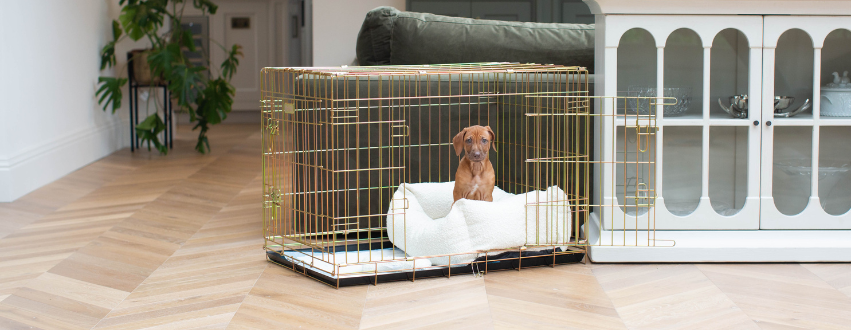Some of the questions we are most frequently asked are related to crate training new puppies; Do I need to crate train my puppy? What size dog crate do I need for my new puppy? Are dog crates cruel?...
This guide is for those who have asked any one of those questions, or any other question related to crate training. Our guide will cover all the reasons to strongly consider crating your puppy; what size crate you might need depending on your puppy’s breed; and how to make the crate an inviting place for your puppy.
What To Use A Dog Crate For
There are a number of benefits to crate training:
- Crates offer a safe, quiet place for nervous pups in their new environment.
- Crates help with toilet training.
- Crates help teach your pup their bedtime routine quickly and efficiently.
- Crates make a great bed and private space for adult dogs, mimicking the “den” like home their canine ancestors would have lived in.
When you first your new puppy home, they will likely be nervous of everything. Whilst they probably came in to contact with all sorts of noises from birth, everything will seem new again when you bring them home. Crates, when used correctly, will offer your pup a calm safe space of their own. It should become their little den where they can go to relax, as well as when you need to contain them for a short time. The crate will also help get them into a routine, helping teach them when it’s time for bed.
As your puppy grows into an adult dog, the crate will become their quiet spot – somewhere for them to enjoy some quiet time and a nap… and maybe a chew on their favourite dog toy!
What NOT to use crates for: Punishment and long-term confinement. This may seem obvious, but crates should never be used as a form of punishment. Rather, they should be seen as a safe space that they can retreat to when they want to relax and get away from the rest of the household. Then if you do need to close your puppy inside for a short time, they will feel relaxed and probably just go to sleep! The last thing you want is for your pup to be nervous of the crate which could lead to destructive behaviour due to stress.
Different Kinds Of Crate
Dog crates fall into three main categories; Metal crates, wooden crates and travel crates.
Metal Crates
The most popular type of crate as they are less expensive than wooden crates and can easily be folded flat for practical storage when not in use. Some may not like the look of the somewhat cage-like metal crates, but when teamed with a fabric cover and bedding set, they become a really cosy den for your dog. We have both traditional metal crates and our new sliding door crate which is perfect for saving space.
Wooden Crates
For those looking for something more substantial, our wooden crates are perfect. They are great if you’re looking for a dual-purpose piece of furniture as they suit a range of interior décor styles and make lovely end tables.
Travel Crate
Travel safety is of utmost importance and restraining your dog when travelling in the car is now a legal requirement. A travel crate is a really practical option for most people as they sit simply in the boot and can fold flat when not in use. They are also needed for travel by sea and air – again, another reason to train your pup in a crate whilst young.
How To Find The Perfect Size Dog Crate
Are you wondering what size dog crate to get? We always suggest choosing a big enough crate for your puppy to grow into as an adult dog. This means you won’t have the expense of upgrading to a larger size later on and your dog won’t have to part with the den that has been their favourite private place for as long as they can remember! When they are fully grown, they should have plenty of head room in the crate - about 3-4” of space, as well as be able to move and turn around freely. The worst thing would be for your dog to be cramped inside.
Dog crates come in a number of different sizes, the most common being 24”, 30”, 36”, 42” and 48” in length. Different brands may vary slightly, but most will offer these most common size options.
These are our size recommendations for each size of crate*:
| 24" Crate (S) | Chihuahua, Jack Russell, Shih Tzu, Yorkshire Terrier and similar breeds |
| 30" Crate (M) | Westie, Beagle, Standard and Miniature Dachshunds, French Bulldog, Border Terrier and similar |
| 36" Crate (L) | Cockapoo, Springer Spaniel, Bulldog and similar breeds |
| 42" Crate (XL) | Labrador, Dalmatian, Labradoodle, English Bull Terrier and similar breeds |
| 48" Crate (XXL) | Golden Retrievers, Greyhounds, Bernese Mountain Dogs and similar breeds |
*These are our general breed size recommendations. When selecting your crate speak to your breeder to find out what crate size they think will be most suitable. Not every dog of a particular breed is the same size. You might have or be expecting a particularly large Frenchie or a very dainty Cockapoo – use our recommendations as a guide and use this with your breeder’s knowledge of the litter for a more accurate size recommendation.
How To Make A Dog Crate More Comfortable
Crates in their purest form are not the most enticing looking things. One of the first things you will want to do is make the dog crate look inviting. When your puppy is young, you’ll probably add a cosy puppy bed and a blanket as well as a cover to help make it feel more private and comfortable. As your pup grows up a full-size crate cushion is the ideal choice.
Our own brand crate bedding has been designed to make your dog’s crate the most comfortable den ever. We make cushions, bumpers and covers in a whole variety of fabrics to suit every taste.
Cushions – Our crate cushions are deeply filled with hollow fibre filling to ensure supreme comfort. The handmade covers are detachable and washable making them super practical. There is also a removable waterproof liner so accidents won’t permeate the inner cushion.
Bumpers – Our bumpers have been designed to create a cosy wall of softness to the inside of your dog’s crate. Sitting around the edge of the cushion, they are perfect for dogs and puppies who like to snuggle up in the corner of their crate. They also look beautiful too!
Covers – Our crate covers are practical and stylish. Our crate covers are handmade in our workshop and turn your bare, draughty crate into a beautiful pet den. They come in a range of fabric choices and feature roll-up doors to help get your pup in their bedtime routine.
How To Make The Perfect Puppy Crate
The crate set-up will be slightly different for a puppy to the crate set-up for an adult dog. If you buy a size suitable for your pup as an adult as we recommend, we’d then suggest the following items to use inside:
Our preferred layout is to pop a piece of Vetbed on the base of the crate then a puppy bed on top in one half; then pop a puppy pad in the other half. Your puppy won’t be able to hold themselves in the first couple of weeks that they’re home so a puppy pad will ensure accidents are easily cleaned. Remember to add in a bowl for water for when your pup is closed inside and a chew toy to help prevent them from nibbling their bed!
When your puppy grows and is fully toilet trained you can swap out the puppy essentials for a full crate set; a cushion, bumper and cover. Our crate sets offer optimum den comfort whilst looking super stylish too! Explore our crate bedding range.






































































































